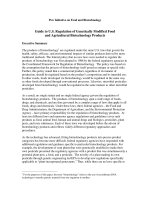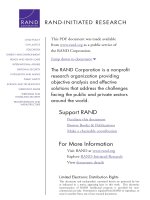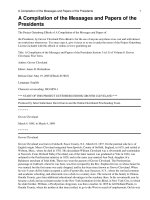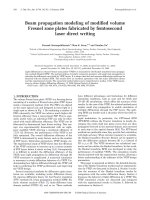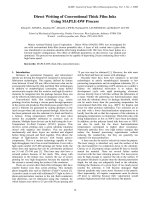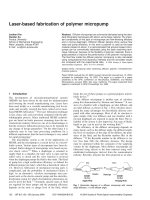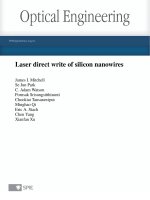laser direct writing of volume modified fresnel
Bạn đang xem bản rút gọn của tài liệu. Xem và tải ngay bản đầy đủ của tài liệu tại đây (417.67 KB, 7 trang )
Laser direct writing of volume modified Fresnel
zone plates
Pornsak Srisungsitthisunti,
1
Okan K. Ersoy,
2
and Xianfan Xu
1,
*
1
School of Mechanical Engineering, Purdue University, West Lafayette, Indiana 47907, USA
2
School of Electrical and Computer Engineering, Purdue University, West Lafayette, Indiana 47907, USA
*
Corresponding author:
Received March 26, 2007; revised April 26, 2007; accepted April 27, 2007;
posted May 17, 2007 (Doc. ID 81435); published August 3, 2007
Volume zone plates consisting of a number of Fresnel zone plate layers are designed and fabricated inside a
fused silica by the femtosecond laser direct writing method. Light diffracted from different layers of a volume
zone plate constructively interfere at the focal spot to increase diffraction efficiency. The technique is experi-
mentally verified to be effective for both low-numerical-aperture (NA) and high-NA zone plates, resulting in a
significant increase in overall diffraction efficiency. The spatial resolution of a high NA volume zone plate is
500 nm. © 2007 Optical Society of America
OCIS codes: 320.7110, 050.1970, 130.3120, 160.2750
.
1. INTRODUCTION
Recently, the use of femtosecond laser direct writing to
produce optical devices inside transparent materials has
been growing considerably. Tightly focused femtosecond
laser pulses can induce nonlinear absorption within the
focal volume and permanently modify the index of refrac-
tion of the material [1,2]. Although the mechanism re-
sponsible for refractive index increase by ultrashort laser
pulses is not fully understood, researchers have fabri-
cated various optical devices inside transparent materials
with this direct writing method. These devices include
waveguides [2,3], gratings [4], and diffractive optical ele-
ments (DOEs) [5–7].
In recent years, the development of fabrication tech-
niques for DOEs has accelerated because DOEs can per-
form many optical functions such as lenses, gratings, op-
tical signal processors, beam splitters, and wavelength
(de)multiplexers. Fabrication of DOEs requires high-
resolution techniques such as lithography. Femtosecond
laser direct writing offers advantages as compared to
other techniques such as volume writing, precision,
speed, simplicity, and flexibility. In particular, this
method of fabrication can be applied for 3D or volume
DOEs without difficulties in mask changing or mask
alignment.
A simple form of DOE is the Fresnel zone plate. The
most attractive features of Fresnel zone plates are their
compactness and capability for high resolution while
maintaining high efficiency. In the absence of losses and
absorptions, an ideal diffractive zone plate can offer 100%
diffraction efficiency provided that the zone plate cor-
rectly modulates phase. In practice, a quantized zone
plate is used as an approximation of the perfect diffrac-
tive lens and its efficiency ranges from 10% to almost
100% depending on the number of quantization levels. A
higher number of phase quantization levels provides
higher efficiency, yet increases complication in fabrica-
tion. A two-level Fresnel zone plate having a focal length f
is constructed with a series of concentric zones whose ra-
dii are defined by [8]
r
n
=
ͱ
nf +
ͩ
n
2
ͪ
2
Ϸ
ͱ
nf, ͑1͒
where the integer n indicates the nth Fresnel zone and
is the operating wavelength. The working principle of the
Fresnel zone plate relies on the fact that the diffraction of
light from alternating zones interferes constructively at
the designed focal point. It is required that the alternat-
ing zones have different transmission properties (i.e., re-
fractive index), and the incident light is monochromatic.
Compared to other fabrication methods, the laser direct
writing technique has the advantage of ease of fabrication
of such a high-efficiency zone plate, eliminating complica-
tions in multistep processes. Studies of direct laser fabri-
cation of Fresnel zone plates inside fused silica have been
reported for both amplitude-type zone plates [5] by utiliz-
ing scattering damage and phase-type [6] zone plates by
refractive index change induced by femtosecond laser
pulses. However, all the previously studied zone plates
suffered from low diffraction efficiency because of effects
such as scattering from damaged regions, phase shift er-
rors due to nonuniform index change inside fused silica,
and planar fabrication. Attempts to fabricate multilevel
phase zone plates by stacking of the index change fila-
ments were also reported, yet had difficulty eliminating
the phase shift errors due to fabrication [7]. The draw-
back of femtosecond laser direct writing is the low refrac-
tive index contrast, which is insufficient to create a single
high-efficiency phase zone plate. Recently, we presented a
new approach of fabricating a number of Fresnel zone
plates or modified Fresnel zone plates within a volume,
which we called volume zone plates, to achieve high dif-
fraction efficiency [9]. By using a series of zone plates, ef-
2090 J. Opt. Soc. Am. B /Vol. 24, No. 9 /September 2007 Srisungsitthisunti et al.
0740-3224/07/092090-7/$15.00 © 2007 Optical Society of America
ficiency is improved significantly, and this method is flex-
ible with different laser writing conditions regardless of
the individual diffraction efficiency. In that work, we fab-
ricated volume zone plates and showed significant in-
creases in diffraction efficiency for both amplitude-type
and phase-type [9]. The highest efficiency of 59.1% was
reported for a phase volume zone plate. According to the
design, each volume Fresnel zone plate operates as a
single diffractive optical element with a much higher dif-
fraction efficiency than a single zone plate.
In this paper, we focus on phase-type volume zone
plates because of their higher efficiency, and our method
is further improved by controlling the filament length for
uniform zone plate thicknesses and also considering the
effects of aberrations. We also characterized the refractive
index changes in the material using different fabrication
parameters to correctly determine the phase shift. In ad-
dition, fabrication of high numerical aperture (NA) vol-
ume zone plates is investigated because they are highly
demanding in microimaging applications. The results in-
dicate that our volume zone plate method is highly effec-
tive for laser direct writing, improving the diffraction ef-
ficiencies up to 71.5% and 7.1% for low NA and high NA
zone plates, respectively. Our high NA volume zone plate
has a resolving resolution on the order of 0.5
m. The rest
of the paper is organized as follows. In Section 2, we de-
scribe the concept and design of the volume modified
Fresnel zone plate. The fabrication processes are de-
scribed in Section 3 in which low NA and high NA Fresnel
zone plates are discussed separately because they rely on
different fabrication approaches. Discussion of results
and conclusions are given in Sections 4 and 5, respec-
tively.
2. DESIGN OF A VOLUME FRESNEL ZONE
PLATE
The concept of a volume Fresnel zone plate is based on
the principle that diffracted light from many Fresnel zone
plates can be effectively coupled together to enhance the
intensity at the focal spot. An incident plane wave was
considered for our design. A volume Fresnel zone plate
consists of a number of layers of modified zone plates cen-
tered on the same optical axis. According to the concept, a
volume modified zone plate should satisfy two conditions:
focal point matching and phase matching. First, each
Fresnel zone plate inside a volume has to be designed spe-
cifically according to its relative location so that all the
zone plates focus light exactly at the same focal point. In
addition, the diffracted light from all the zone plates must
be “in phase,” while the phase at the focal point can be
chosen arbitrarily. In other words, the phase shifts pro-
duced by every zone plate are the same at the focal point
so that the diffracted light from all the zone plates con-
structively interferes at the focal point.
Equation (1) is valid only when a Fresnel zone plate dif-
fracts light in a medium of constant index of refraction.
For our case, the volume zone plate operated inside a
glass substrate whereas the focal point is in air. There-
fore, we also took into account the phase shift by the re-
fractive index of the glass and the refraction of light at
the air-glass interface. The phase shift due to wave propa-
gation in a homogeneous medium can be calculated by
[10]
=2
nt/, where n is the index of refraction of the
medium, and t is the propagation distance. In Fig. 1, the
volume zone plate contains two layers of modified Fresnel
zone plates and optical path length in air and glass are
shown.
In the design process, the number of layers in a volume
and the spacing between zone plates need to be initially
chosen. The spacing between zones is arbitrary but must
be greater than the thickness of a zone plate to avoid
overlapping of zone plates. Then, the radii of zone plates
are generated by applying Eq. (1) with adjusted focal
length, f
i
, according to the axial distance from the focal
point. The total optical path length was calculated by add-
ing the traveling distance in air and glass, considering
Snell’s angle of refraction. Iteratively, the radii of the
zones in each Fresnel zone plate are slightly adjusted to
satisfy the phase matching requirement. For example,
two zone boundaries (r
1
and r
2
), shown in Fig. 1, are ad-
justed during the design by using Eqs. (2) and (3) below,
such that their phase remainders are equal ͑b1=b2͒ at
the end of the numerical iterations:
1
=
air,1
+
glass,1
=
2
͑t
air,1
+ n
glass,1
t
glass,1
͒ =2
m
1
+ b
1
,
͑2͒
2
=
air,2
+
glass,2
=
2
͑t
air,2
+ n
glass,2
t
glass,2
͒ =2
m
2
+ b
2
.
͑3͒
Once all the modified zones have the same phase shift at
the focal point, the volume modified Fresnel zone plate
reaches the highest diffraction efficiency.
For ease of fabrication with minimum phase errors, an-
other modification of the Fresnel zone plate is to fabricate
the central rings only instead of full zones [9]. In this
modification, each complete zonewidth is replaced by a
single central ring in the middle of the zone, as shown in
Fig. 2. With this approach, several advantages are
achieved. Implementation time is greatly reduced. Since
the central circle of each ring corresponds to the exact
phase desired, the method is robust against small imple-
Fig. 1. Geometry used in phase computation for volume modi-
fied zone plate.
Srisungsitthisunti et al. Vol. 24, No. 9 / September 2007 /J. Opt. Soc. Am. B 2091
mentation errors [11]. Hence, the advantages of central
rings replacing full zones are especially amplified in the
implementation of volume zone plates. In addition, the
full zone is not suitable for line by line scanning because
the refractive index change is not uniform within the ir-
radiated region such that it is difficult to create a uniform
index change across the full zone. Although the individual
diffraction efficiency of the central-ring zone plate de-
creases, the overall efficiency of the volume zone plate
will increase because the central rings minimize the in-
terfering effect of different zone plates [9]. The full zone is
not suitable for volume diffraction because the strong in-
teraction of each zone plate causes light to diffract mul-
tiple times and focus at different spots.
According to the above concept and modifications, the
volume zone plate should coherently focus light at the
single spot with minimum phase mismatching. By assum-
ing each zone plate has low efficiency, the light diffracted
from each modified Fresnel zone plate could be considered
to be a small percentage of the total beam. The rest of the
main beam transmits and is diffracted by the next layers.
As the number of layers increases, the coherent interac-
tion between the zone plates allows the diffraction effi-
ciency to increase. Nevertheless, when the number of lay-
ers increases beyond a certain number, other effects such
as phase shift error and fabrication error could accumu-
late and eventually diminish the diffraction efficiency of
the volume zone plate.
3. EXPERIMENTS
In the experiments, a fused silica sample optically pol-
ished on all surfaces was fixed on a computer-controlled
x–y –z air bearing stage that has a translational accuracy
of 200 nm. The sample was irradiated by 90 fs pulses de-
livered by a Ti:sapphire amplified laser system at a cen-
tral wavelength of 800 nm and 1 kHz repetition rate. The
laser beam was attenuated before being focused inside
the bulk of fused silica. An electronic shutter was con-
nected to the computer controller, allowing the laser ex-
posure and the stage movement to be synchronized. The
fabrication process was monitored in real time via a CCD
camera imaging on a TV screen.
In femtosecond laser direct writing, both the change in
index of refraction and the shape of the filament where
change of index of refraction occurs are sensitive to laser
processing parameters such as laser frequency, pulse en-
ergy, scanning speed, focusing conditions, and focusing
depth from the surface. For volume Fresnel zone plate
fabrication, the processing parameters need to be ad-
justed when fabricating different layers because the fo-
cusing depth has influence on the change in the index of
refraction caused by spherical aberration. The confocal
distance is a function of self-focusing and spherical aber-
ration. As reported by Sun et al. [12], the spherical aber-
ration induced by air-glass interface extends the focal re-
gion toward the laser propagating direction. For deep
focusing, this interface spherical aberration significantly
increases the length and distorts the shape of the fila-
ment induced by femtosecond laser pulses. At the same
laser writing condition, we experimentally found that the
length of region with index change was relatively longer
at the deeper position from the surface depending on the
focusing condition. For example, using a 5ϫ objective lens
͑NA=0.15͒, the filament length was 100
m at 0.5 mm be-
low the surface compared to the filament length of
250
m at 2 mm below the surface. This discrepancy in
length was undesirable for the volume zone plate because
we need consistent thickness of each zone plate to deter-
mine the influence of the number of layers used in the vol-
ume zone plate. To obtain a constant filament length for
all layers, we applied a different laser energy for a differ-
ent depth of fabrication. The laser energy and writing
conditions required for a specific depth were experimen-
tally predetermined for the above reasons.
In what follows, we will first describe characterization
of the change in index of refraction caused by different la-
ser parameters. Since low and high NA zone plates are
fabricated using different methods, they will be described
separately in Subsections 3.A and 3.B.
A. Measurement of Refractive Index Change
The 5ϫ and 100ϫ objective lenses were used to fabricate
low and high NA volume zone plates, respectively. An es-
timation of refractive index changes due to femtosecond
pulses focused by 5ϫ and 100ϫ lenses were necessary to
correctly predict the phase shift by fabricated volume
zone plates. Usually, the refractive index change due to
femtosecond laser pulses is not uniform along the fila-
ment length, and it is difficult to measure such a small
index change directly. However, the amount of refractive
index change can be estimated by fabrication of gratings
and measuring their diffraction efficiencies. Based on a
Kogelnik’s coupled wave theory [13], the index change can
be estimated by
⌬n =
cos
B
t
sin
−1
ͱ
n, ͑4͒
where
B
is the Bragg incident angle, t is the thickness of
the grating (filament length), and
is the first-order dif-
fraction efficiency. According to Solymar and Crook [14],
the coupled wave theory by Kogelnik offers good accuracy
when dealing with thick grating ͑QϾ 10͒. In our case, the
low NA volume zone plates were fabricated with much
longer index filament than that of the high NA volume
zone plates. The index filament lengths were 120 and
8
m for low and high NA, respectively. Therefore, the
corresponding fabricated gratings give the value for Q
Fig. 2. (a) “Full” Fresnel zone plate showing central rings in the
middle of each zone. (b) Modified zone plate with central rings
(thickness determined by laser writing).
2092 J. Opt. Soc. Am. B / Vol. 24, No. 9 / September 2007 Srisungsitthisunti et al.
=65 for low NA volume zone plates and Q=11 for high NA
volume zone plates. The grating pitches were 5 and 2
m
for respective low and high NA volume zone plates, and
the efficiencies of gratings were measured with He–Ne
laser ͑632.8 nm͒. As a result, it is valid to estimate the re-
fractive index increase by using the coupled wave theory.
We fabricated phase gratings inside fused silica using
the same conditions as with the volume zone plates. The
diffraction efficiencies of gratings were measured at the
He–Ne laser wavelength ͑632.8 nm͒. The estimation of
the refractive index increases were 0.16ϫ 10
−3
for the la-
ser processing conditions used for fabricating low NA vol-
ume zone plates and 1.8ϫ 10
−3
for the laser processing
conditions used for fabricating high NA volume zone
plates.
B. Low-Numerical-Aperture Volume Zone Plates
Phase-type volume Fresnel zone plates with a focal length
of 20 mm and a diameter of 0.8 mm ͑NA= 0.02͒ were fab-
ricated. Each layer of Fresnel zone plate consisted of 20
zones (10 central rings). First, we characterized a single
layer phase zone plate and found that the pulse energy of
10–15
J and 10
m/s laser scanning speed were the op-
timum conditions for generating a phase zone plate when
using a 5ϫ objective lens ͑NA=0.15͒. At 0.5 mm below the
surface, the change of the index of refraction caused by
each pulse was elongated over a length, which is deter-
mined by the Rayleigh range, resulting in a 120
m long
filament of refractive index change. The filament lengths
were predetermined for the specific pulse energies and
depths of fabrication from the silica surface. Single layer
zone plates were fabricated using central rings instead of
“full zones” as discussed previously to reduce the fabrica-
tion time. The width of each ring depended on laser writ-
ing conditions: focusing lens and depth of fabrication. Us-
inga5ϫ objective lens, the linewidth of the refractive
index change was ϳ3
m. With this approach, the fabri-
cation time of a modified phase zone plate was 40 min.
According to our estimation of index increase, the
phase shift of He– Ne laser passing through a single layer
zone plate was 0.08
. Thus, the combination of refractive
index change and the filament length of single layer zone
plate were not enough to achieve a
phase shift, which is
required for a phase reversal zone plate to achieve high
diffraction efficiency. Further increase in phase shift can
be obtained by either increasing the refractive index
change or extending the filament length. Here, we use the
volume zone plate method as an alternative to increase
the diffraction efficiency.
The volume zone plates were fabricated layer by layer
starting with the deepest layer from the surface facing
the laser. Each layer was carefully placed according to the
design equations to assure that all the layers would
couple light together at the focus with constructive inter-
ference. The deeper layers were fabricated with less en-
ergy to maintain a constant thickness of each zone plate.
The separation distance between the layers was approxi-
mately 200
m, namely, about twice the thickness of each
zone plate, and the zone plate closest to the surface was
fabricated at 500
m beneath the silica surface. The low
NA volume zone plates containing up to ten layers of
Fresnel zone plates were fabricated to determine their fo-
cusing performance.
C. High-Numerical-Aperture Volume Zone Plates
We also fabricated high NA volume zone plates that can
diffract light at a large converging angle at a short focal
length. A Fresnel zone plate with high NA offers a high-
resolution focal spot, and it has potential in various opti-
cal applications. For such a short focal length zone plate,
the Fresnel zones (rings) are densely spaced, and there-
fore high-resolution fabrication is needed. The closest
separation distance between the adjacent zones becomes
smaller as the diameter of the zone plate increases ac-
cording to Eq. (1). Theoretically, the resolution of a high
NA Fresnel zone plate is determined by the smallest zone
width that can be produced by the fabrication method.
The resolution limit is given by [15] d=0.61 /NA
Ϸ1.22⌬r
N
where ⌬r
N
is the width of the outermost zone.
In addition, aberrations such as spherical aberration be-
come noticeable with the high NA Fresnel zone plate
when the number of zones (transparent and opaque) are
larger than N =
ͱ
2f / [15]. Therefore, our high NA zone
plates could be affected by spherical aberration.
The fabrication parameters were determined experi-
mentally to achieve the smallest linewidth of refractive
index change inside fused silica. This linewidth deter-
mined our limit in fabrication resolution. The linewidth of
ϳ1
m could be produced using a 100ϫ objective lens
͑NA=0.80͒, a laser scanning speed of 10
m/s and a pulse
energy of 0.1
J. First, we fabricated single layer Fresnel
zone plates having NA ranging from 0.66 to 0.91 and a fo-
cal length of 60–130
m. The diameters of these high NA
zone plates were approximately 100
m. The designs of
all the high NA zone plates were limited by 1
m mini-
mum zone separation distance at the outermost zones.
Similar to the low NA case, we fabricated zone plates with
central-ring zones instead of full zones. Central zones
were also more crucial in this case to minimize phase er-
rors because the zones were much narrower in high NA
zone plates, and writing a full zone with an exact width
was extremely difficult. Central-ring high NA zone plates
contained 50–90 rings depending on their designed NA.
The fabrication time for each high NA zone plate was
40–60 min.
Fig. 3. Diffraction efficiency as a function of the number of
modified phase zone plates in a volume.
Srisungsitthisunti et al. Vol. 24, No. 9 / September 2007 /J. Opt. Soc. Am. B 2093
For a high NA volume zone plate, the spacing between
layers had to be as close as possible because a small
change in focal length causes the NA number to decrease
significantly. The NA number of the volume zone plate
was defined by using the longest focal length of the gen-
erated zone plates. Volume zone plates with NA=0.84
were fabricated up to five layers to observe an increase in
diffraction efficiency.
4. RESULTS AND DISCUSSION
A. Low-Numerical-Aperture Zone Plates
The fabricated volume Fresnel zone plates were tested for
their diffraction efficiencies using a He– Ne laser at a
wavelength of 632.8 nm. The method for measuring the
diffraction efficiency has been described previously [9].
Our single layer phase zone plates had an efficiency of
5.3%. As expected, this low efficiency was due to the small
change of the index of refraction that was insufficient to
induce a
phase shift. By adding more layers to build a
volume phase zone plate, the highest efficiency of a vol-
ume zone plate with central rings was improved to 71.5%
with eight layers of phase zone plates. This efficiency was
higher than the previously published result [9] even
though the number of layers was the same because of a
better control of filament length and index increase. Fig-
ure 3 shows the measured efficiencies of volume Fresnel
zone plates as a function of the number of layers of zone
plates. This result implied that the volume method was
more effective than simply stacking the zone plates to
achieve the
phase shift because the efficiency exceeded
the maximum possible of 40% by a phase-reversal zone
plate. The increase in diffraction efficiency of the volume
zone plate can be explained in terms of coherent addition
of light from different zone plates [8]. For example, the in-
tensity due to two zone plates can be written as I= I
1
+I
2
+2
ͱ
I
1
I
2
cos
␦
where
␦
is the phase shift between the two.
In our case, we specified zero phase shift so that dif-
fracted intensity is as large as possible. However, the dif-
fraction efficiency could not be simply predicted by only
the coherent addition of beams because there are other ef-
fects involved, such as multiple diffractions from one
layer to the next layers, which required a rigorous analy-
sis.
Without a model simulation, it is hard to confirm that
the possible maximum efficiency is 71.5%. The coherent
addition of diffracted waves allows the volume zone plates
to achieve relatively high efficiencies compared to binary
zone plates. These volume zone plates can be further op-
timized by changing the laser scanning speed to fabricate
a zone plate with different efficiency at each layer. The
maximum efficiency is believed to be a function of such
processing. The imperfection in manufacturing also
causes a decrease in efficiency, which is hard to estimate
in the simulation. Further investigation requires more
careful study of refractive index change and numerical
simulation of light diffraction from a volume zone plate.
Also, the efficiency is expected to be a wavelength depen-
dent property.
The images at the focal spots of the low NA volume
zone plates are shown in Fig. 4. The spot size was mini-
mally affected by aberrations, and the focal spot produced
by the eight layer phase volume zone plate was ϳ20
m
at full width at half maximum (FWHM), which agreed
with the theoretical value of 19.3
m. The volume phase
zone plates had a significant increase in diffraction effi-
ciency when having eight layers. However, ten layers or
more of zone plates started to show a decrease in effi-
ciency. This decrease can be explained by three possible
reasons: (1) interaction of light passing through many lay-
ers causes phase and focal position error at the focal
point, (2) light absorption or scattering becomes notice-
able with many phase layers, and (3) accumulated fabri-
cation errors.
Fig. 4. Focal spots of low NA volume phase zone plates with
central rings.
Fig. 5. Diffraction efficiency of single layer zone plate ͑NA
=0.66– 0.91͒.
Fig. 6. Experimental spatial resolutions compared with the
Rayleigh criterion of single layer high NA zone plates.
2094 J. Opt. Soc. Am. B / Vol. 24, No. 9 / September 2007 Srisungsitthisunti et al.
B. High Numerical Aperture Zone Plates
For the high NA zone plate, the diffraction efficiency is
low, which causes relatively large measurement uncer-
tainties. The results of single layer high NA zone plates
are shown in Fig. 5, together with the estimated measure-
ment uncertainties. For a single layer zone plate of NA
=0.66–0.91, the diffraction efficiency trended to be
slightly higher for a lower NA zone plate. The possible
reason is that the higher NA zone plates were partially
overlapped at the outer zones, resulting in more phase
shift error. The single layer high NA zone plates had effi-
ciencies of 4.5% to 3.5% for NA from 0.66 to 0.91. The
lower diffraction efficiency as compared to a low NA vol-
ume zone plate is mainly due to the much shorter fila-
ment length produced by a high NA objective lens.
In the study of high NA zone plates, we were especially
interested in reducing the focal spot size or improving the
spatial resolution of the zone plate since these fabricated
zone plates are often intended for high-resolution applica-
tions. Our single layer high NA zone plates could produce
a spot as small as 0.5
m (FWHM) for a zone plate with
an NA=0.91. Figure 6 compares our experimental resolu-
tion of high NA zone plates with the Rayleigh criterion.
The focal spots of our zone plates were larger than the
predicted values, possibly because of aberrations and
overlapped zones. The overlapped zones reduced the effec-
tive diameter of the zone plate and lowered the effective
NA. On the other hand, the smallest spot size for high NA
zone plate still showed good Gaussian profile as shown in
Fig. 7.
The diffraction efficiencies and the corresponding focal
spot sizes of volume zone plates with NA=0.84 having up
to five layers are shown in Fig. 8. The maximum efficiency
of 7.1% was obtained with a two-layer zone plate, and the
focal spot size increased with the number of layers. With
two layers, the diffraction efficiency was maximized while
the total phase shift was only 0.06
. This phase shift
could be increased with more layers but there were other
factors that diminished efficiency as the number of layers
increased. Therefore, we used a high magnification micro-
scope to observe the filament induced by a 100ϫ objective,
and found a dim spot on top of the filament. This dim spot
indicates optical damage produced by a tightly focused
femtosecond pulse. Therefore, the high NA zone plate pro-
duced by a 100ϫ objective might not be purely phase-type
and can absorb light. Absorption could be a significant
cause for efficiency reduction when the number of layers
increases. Accumulation of fabrication errors can limit the
high-resolution performance when the number of layers
increases.
5. CONCLUSIONS
We designed and fabricated low and high NA volume
Fresnel zone plates inside a bulk of fused silica by femto-
second laser direct writing. A new technique for modified
Fresnel zone plates in which only the central ring of each
zone was irradiated by a laser was used to greatly reduce
fabrication time and phase errors. Efficiency as high as
71.5% was obtained for a low NA volume zone plate con-
sisting of eight layers. High NA zone plates were also suc-
cessfully fabricated. Compared to low NA zone plates,
high NA zone plates had much shorter filament length
and absorbed light, resulting in lower diffraction efficien-
cies. Nevertheless, volume zone plates could offer much
higher efficiency than single layer zone plates with spa-
tial resolution of 500 nm. More rigorous design, optimiza-
tion, and improved fabrication techniques are needed to
further increase the performance, especially for high NA
volume zone plates.
ACKNOWLEDGMENT
This work was supported by the National Science Foun-
dation under grant 0335074.
REFERENCES
1. T. Tamaki, W. Watanabe, H. Nagai, M. Yoshida, J. Nishii,
and K. Itoh, “Structural modification in fused silica by a
femtosecond fiber laser at 1558 nm,” Opt. Express 14,
6971–6980 (2006).
2. A. M. Streltsov and N. F. Borrelli, “Study of femtosecond-
laser-written waveguides in glasses,” J. Opt. Soc. Am. B 19,
2496–2504 (2002).
3. R. Osellame, S. Taccheo, M. Maríangoni, R. Ramponi, P.
Laporta, D. Polli, S. De Silvestri, and G. Cerullo,
“Femtosecond writing of active optical waveguides with
astigmatically shaped beams,” J. Opt. Soc. Am. B 20,
1559–1567 (2003).
4. N. Takeshima, Y. Narita, S. Tanaka, Y. Kuroiwa, and K.
Hirao, “Fabrication of high-efficiency diffraction gratings in
glass,” Opt. Lett. 30, 352–354 (2005).
5. W. Watanabe, D. Kuroda, K. Itoh, and J. Nishii,
“Fabrication of Fresnel zone plate embedded in silica glass
Fig. 7. Focal spot of high NA zone plate (NA=0.91, f =60
m).
Fig. 8. Diffraction efficiencies and focal diameters of high NA
volume zone plates ͑NA= 0.8͒.
Srisungsitthisunti et al. Vol. 24, No. 9 / September 2007 /J. Opt. Soc. Am. B 2095
by femtosecond laser pulses,” Opt. Express 10, 978–983
(2002).
6. E. Bricchi, J. D. Mills, P. G. Kazansky, B. G. Klappauf, and
J. J. Baumberg, “Birefringent Fresnel zone plates in silica
fabricated by femtosecond laser machining,” Opt. Lett. 27,
2200–2202 (2002).
7. K. Yamada, W. Watanabe, Y. Li, K. Itoh, and J. Nishii,
“Multilevel phase-type diffractive lenses in silica glass
induced by filamentation of femtosecond laser pulses,” Opt.
Lett. 29, 1846–1848 (2004).
8. F. L. Pedrotti and L. S. Pedrotti, Introduction to Optics, 2nd
ed. (Prentice Hall, 1993), pp. 374–376.
9. P. Srisungsitthisunti, O. K. Ersoy, and X. Xu, “Volume
Fresnel zone plates fabricated by femtosecond laser direct
writing,” Appl. Phys. Lett. 90, 011104 (2007).
10. M. Born and E. Wolf, Principles of Optics: Electromagnetic
Theory of Propagation, Interference and Diffraction of
Light, 7th (expanded) ed. (Cambridge U. Press, 1999), pp.
54–55.
11. O. K. Ersoy, “Construction of point images with the
scanning electron microscope: a simple algorithm,” Optik
(Jena) 46, 61–66 (1976).
12. Q. Sun, H. Jiang, Y. Liu, Y. Zhou, H. Yang, and Q. Gong,
“Effect of spherical aberration on the propagation of a
tightly focused femtosecond laser pulse inside fused silica,”
J. Opt. A, Pure Appl. Opt. 7, 655–659 (2005).
13. T. Toma, Y. Furuya, W. Watanabe, J. Nishii, K. Hayashi,
and K. Itoh, “Estimation of the refractive index change in
glass induced by femtosecond laser pulses,” Opt. Rev. 7,
14–17 (2000).
14. L. Solymar and D. J. Cooke, Volume Holography and
Volume Gratings (Academic, 1981).
15. H. D. Hristov, Fresnel Zones in Wireless Links, Zone Plate
Lenses and Antennas (Artech House, 2000), pp. 157–160.
2096 J. Opt. Soc. Am. B / Vol. 24, No. 9 / September 2007 Srisungsitthisunti et al.



